:
1. TO DETER SEED PREDATION: Plant seeds at least 3 inches deep (4 to 6 inches may be best). Flat rocks placed over a seed may also help, but the dangers of rocks are that they attract ants, may prevent the seed from accessing rain, and may force the germinating stem to circle around before finding a way to pop out the side (usually upslope). See PHOTOS of good and bad results at this section of our detailed free-planting webpage.
2. TO DETER ABOVE-GROUND HERBIVORY: Newly emerged stems and leaves are vulnerable to toothed herbivores upon emergence. Even when the needle-like leaf tips harden, deer and rodents may still nibble and sample. As a subcanopy-adapted tree, Torreya is usually capable of regrowing — again and again, very quickly adding extra vertical stems (as well as regrowing lateral branches) so that the little seedling becomes less and less vulnerable to herbivory as the years pass. (See photos of herbivory recovery on our free-planting webpage.) As of 2019, we have several siting recommendations for free-planted seeds that are not given any wire protection upon germination:
2A. PLANT SEEDS WHERE DEER ARE LEAST LIKELY TO VENTURE: Possibilities include a deep densely vegetated ravine and the steepest slope you can find. Possibly within the thicket of branches of a recent treefall.
2B. PLANT SEEDS WITHIN THE OUTER REACH OF EVERGREEN FERNS. Fall of 2018, three locations documented that the only free-planted individuals that had escaped above-ground herbivory after three or more years were camouflaged during the winter by evergreen fern fronds. One of the three examples is shown in photos below.
♦ FIND THE TORREYA IN THE PHOTO DIRECTLY BELOW:

 |
|
The Torreya LEFT has the same camera angle as the photo ABOVE, so you can definitely find it on your own. This perfect little seedling showed no sign of herbivory. (December 2018)
This rural area of NE Alabama is a patchwork of cattle grazing and other fields, regrowth forest, and routine logging. Deer are not abundant and certainly not overpopulated here. But prints do turn up regularly in muddy sections of this forest.
This was the only one of 13 emerged seedlings camouflaged by Christmas fern fronds — and it was the only one not damaged by herbivory.
|
• 2018: BILTMORE HEALTH BOOSTS ARGUMENT AGAINST GENETIC ENGINEERING
By the 1950s one or more of a number of documented diseases was consistently resulting in stem dieback of a great proportion of Torreya specimens in their native Florida habitat. Until 2010, the posited disease agents were multiple (and included below-ground diseases that perhaps weakened the plant enough to undermine its evolved ability to fight off native water molds, including the then-identified stem-canker agent, Fusarium lateritium). Beginning in 2010, a single canker disease agent was the focus of Prof. Jason Smith's inquiry. This led to today's widely reported conclusion that Smith's newly named Fusarium torreyae is itself the cause of stem dieback today, and presumably was the cause in the 1950s too. The crucial observation — that the Fusarium is already present at a northward site — was reported by Jason Smith (in an email to Torreya Guardian Connie Barlow, 20 February 2018). Smith wrote:
There is no doubt in my mind that the primary driver in the mortality of the trees is the pathogen. It is reasonable to assume that it is easily moved around. Furthermore, my M.S. Student, Aaron Trulock, completed a study that demonstrated that several conifer species native to the southern Appalachians are susceptible, with a couple of species being highly susceptible (Fraser fir, hemlock).... This raise a flag of caution that any planted material there should come from disease-free trees and every effort should go into not introducing it. We did confirm that the trees at Biltmore Estate in Asheville already are infected, for example… [the end ellipsis was in the original]
Eight months after receiving Smith's email, Connie Barlow had an opportunity to visit Biltmore Gardens for about the fifth time since she began work on her 2001 book, The Ghosts of Evolution, during which Torreya's status as a left-behind glacial relict sparked her interest. October 2018 Barlow visited the Biltmore Torreyas and observed good health, male and female first-year cone buds, and one (previously unreported sapling; photo below right) with 23 ripening seeds. See photos below:
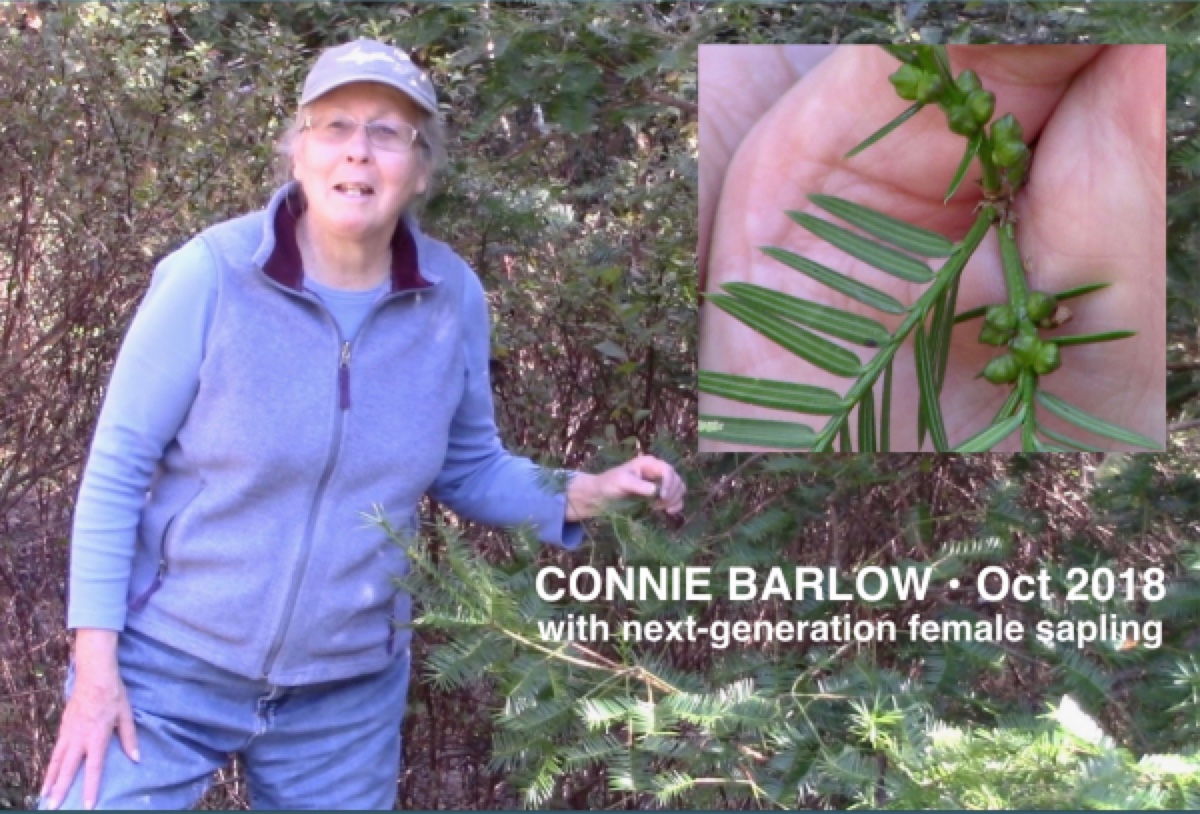

Several previous text sources also mention stem canker as present at the Biltmore Gardens in North Carolina, so the pathogen has presumably had more than three decades to manifest serious injuries. Page 3 of the 1986 original recovery plan states:
Mature torreya trees exist in cultivation at the Biltmore House and Gardens near Asheville, North Carolina, but even there, seedlings and young trees show blight symptoms similar to those seen in trees in Florida. There has been no testing or identification of pathogens from the trees at Biltmore. The 14 large trees, approximately 40 years old, show occasional lesions but appear to be healthy. They may have escaped more serious symptoms because they suffer little water stress in the cool, moist climate (Barnes 1983a, Turnage 1985).
Torreya Guardians have repeatedly documented healthy stems and cone production on original and naturally recruited specimens at the Biltmore. Photographs and videos posted online enable other parties to view and interpret this conclusion. If our declaration of health is corroborated by Biltmore horticultural staff, and if others so interpret by viewing the photos and videos, then northward translocation is a well-supported strategy for species recovery. Moreover, existing and potential translocations comprise a far less controversial approach than does a University of Florida proposal for genetic manipulation aimed at inserting disease resistance (from a different plant taxon) so that the peak-glacial refuge might be restocked with engineered embryos that could possibly cope with a too-warm (and still warming) climate zone.
• 2018: DOCUMENTATION OF ADAPTIVE GROWTH FORMS (10 YEAR RESULTS)
UPDATED WEBPAGE: The Lake Junaluska locale in North Carolina (planted with 10 potted seedlings in 2008) offers insights for helping endangered species recovery ten years later. ADAPTIVE GROWTH FORMS is one of the key insights:
ADAPTIVE GROWTH FORMS - If afforded the opportunity to grow in open sunlight, Torreya takes the form of a standard conifer. If the habitat is shaded subcanopy, its form is yew-like and growth is much slower. Because Torreya genus is not a pioneer-sere taxon, only human intervention in cutting back overgrowth shade can maximize Torreya's growth potential and induce an upright form (and early seed production). As of 2018, no reproductive structures have been observed on even the tallest individuals.
1. HORIZONTAL V. VERTICAL GROWTH FORMS:
 |
|
VIDEO 29: Florida Torreya to Lake Junaluska NC - 2018 update
Ten years after the 2008 planting of ten potted seedlings as a first "assisted migration" project (reported on by Audubon Magazine), Connie Barlow returns to document ongoing results. The challenges, the successes, and the learnings are all topics covered here and also on the Lake Junaluska webpage.
A key learning is how Torreya is capable of adapting its growth form to conditions of shade (horizontal, yew-like form) or abundant sunlight (standard conifer form).
|
2. LONG, GROUND-LYING BRANCH ADAPTATION:
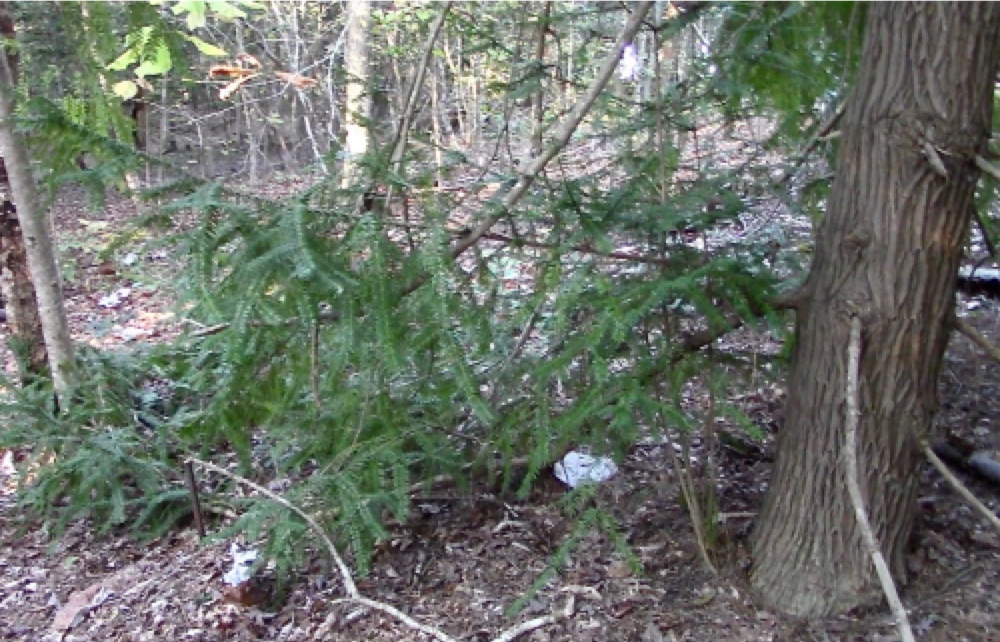
|
|
Autumn 2018 Torreya Guardians Clint Bancroft and Connie Barlow visited 3 mature Florida Torreyas planted 68 years ago at DORMON NATURE PRESERVE in north-central Louisiana.
PHOTO LEFT: At Louisiana's Dormon Preserve, Torreya Guardians photo-documented the third example of the ground-trending, long-branch growth form that we had documented previously at two North Carolina sites of near-century-old groves.
Note: The photo left appears on the new in 2018 Louisiana Torreya webpage. Barlow also captured video footage during the site visit, published on youtube as a 70-minute VIDEO in two parts (episode 30) "Florida Torreya in Louisiana - Mature Grove with Seedlings".
|
One hypothesis for the conditions that trigger this growth form is that a torreya tree that begins its life in open sunlight (and thus assumes a vertical-trending, conical conifer form), has a back-up adaptation if and when fast-growing species of trees close in and begin to overtop it. That growth form is this:
GROWTH FORM ADAPTATION TO OVERTOPPING: One (or more) of Torreya's lower branches on the sunniest side, usually south-facing, and which emerge no more than 3 feet above ground on the main stem, will reestablish fast horizontal growth. The branches will be supported by the ground in their quest to reach sunlight. When direct sunlight is accessed, the branch thickly fills out leaves and branchlets to maximize solar collection. Branch lengths easily reach out 20 or 30 feet distance from the main stem, while the thickness of the branch at trunk emergence remains uncharacteristically thin, thanks to ground-level support.
The photos below show the same ground-lying branch form at two other mature groves:
BELOW LEFT is BILTMORE (NC) 2018.
Right is HARBISON HOUSE (NC) 2015 with Jack Johnston.
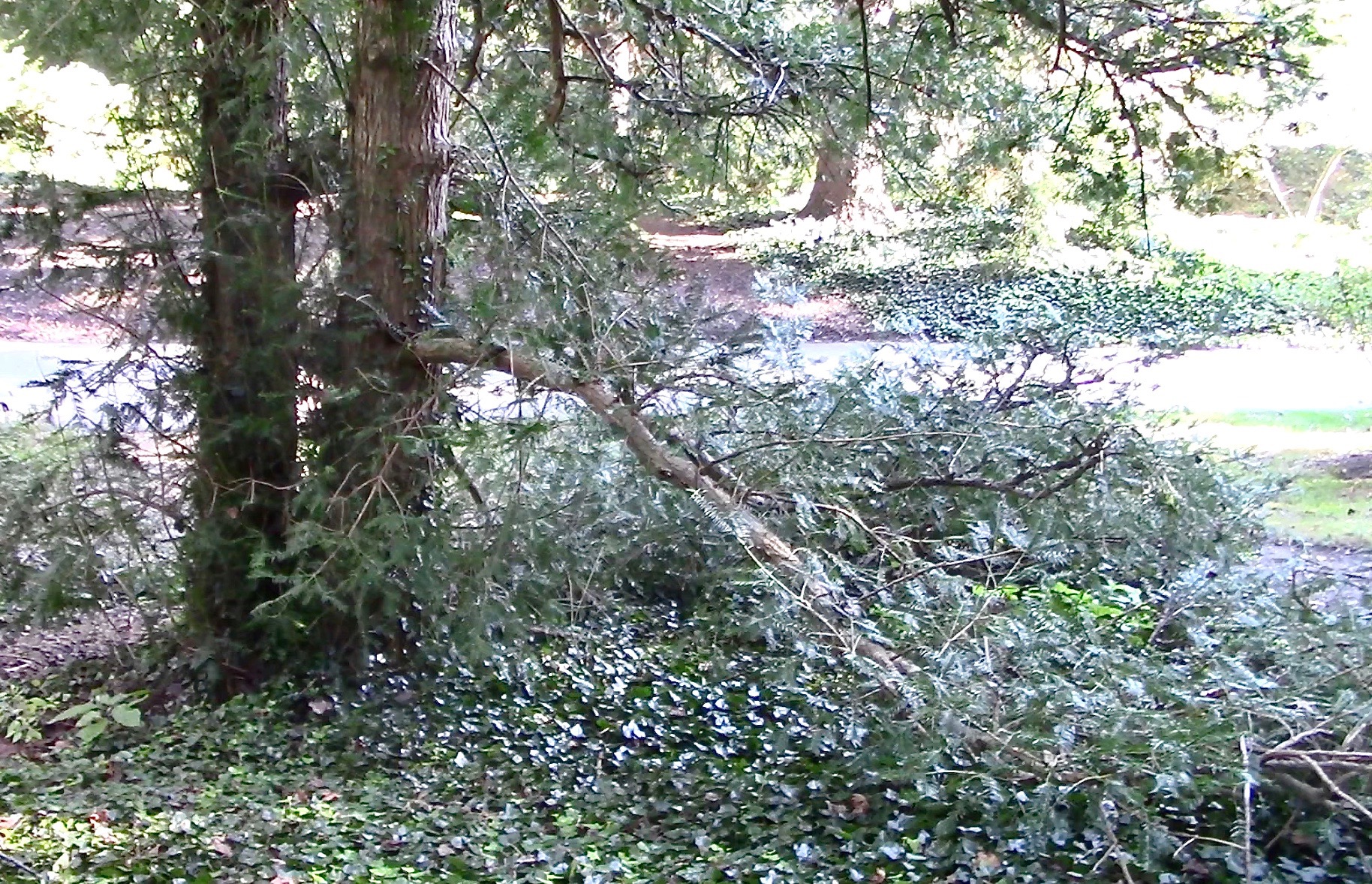
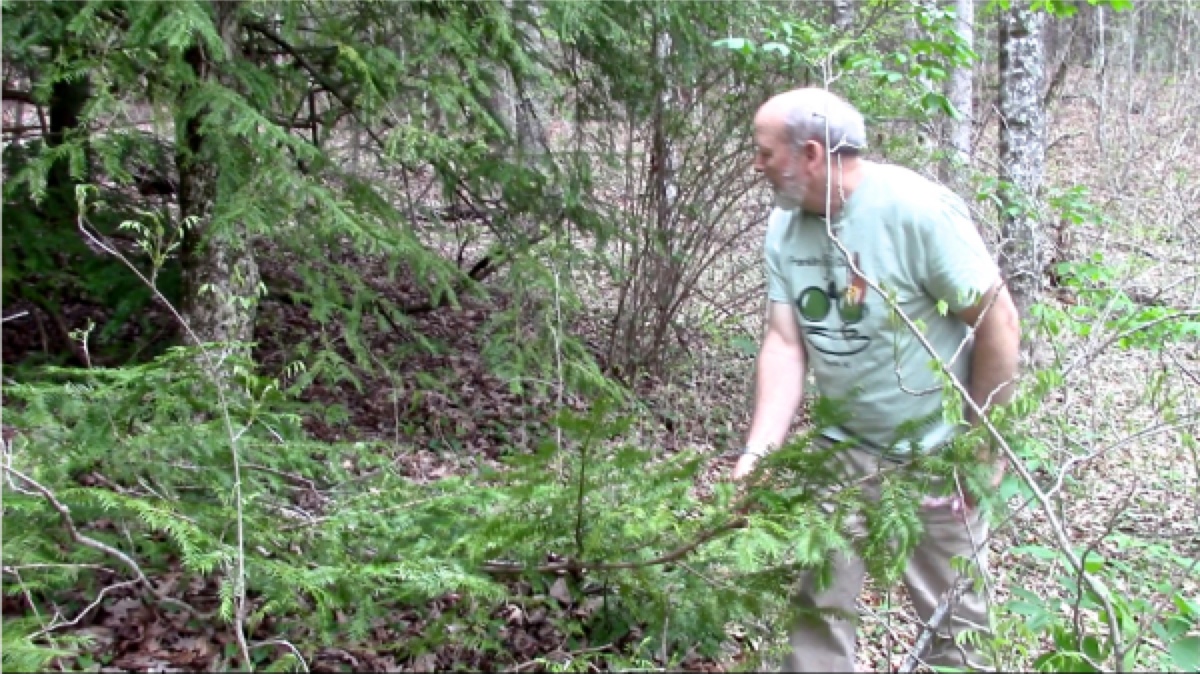
NOTE: A USFS webpage has this mention of the LAYERING growth habit: "California nutmeg sprouts from the roots, root crown, and bole
following damage to aboveground portions of the tree [3,10,19]. Some
nutmegs reproduce by layering [21], but the layering capacity of
California nutmeg is unknown." See: USFS "Fire Effects" species page on Torreya californica.
3. FULL EXPOSURE PRODUCES DENSE FORM (and COLD CLIMATE HIDDEN SEEDS)
While more photos and comparisons are needed, it is becoming apparent that in full-exposure sites, Florida Torreya assumes a much denser growth form than when in shady, inner forest sites. Two photos immediately below show dense growth forms in New York (below left) and also in North Carolina (below right).
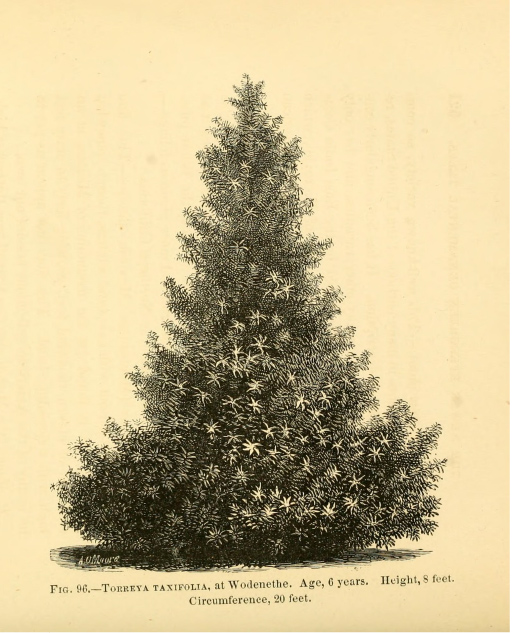
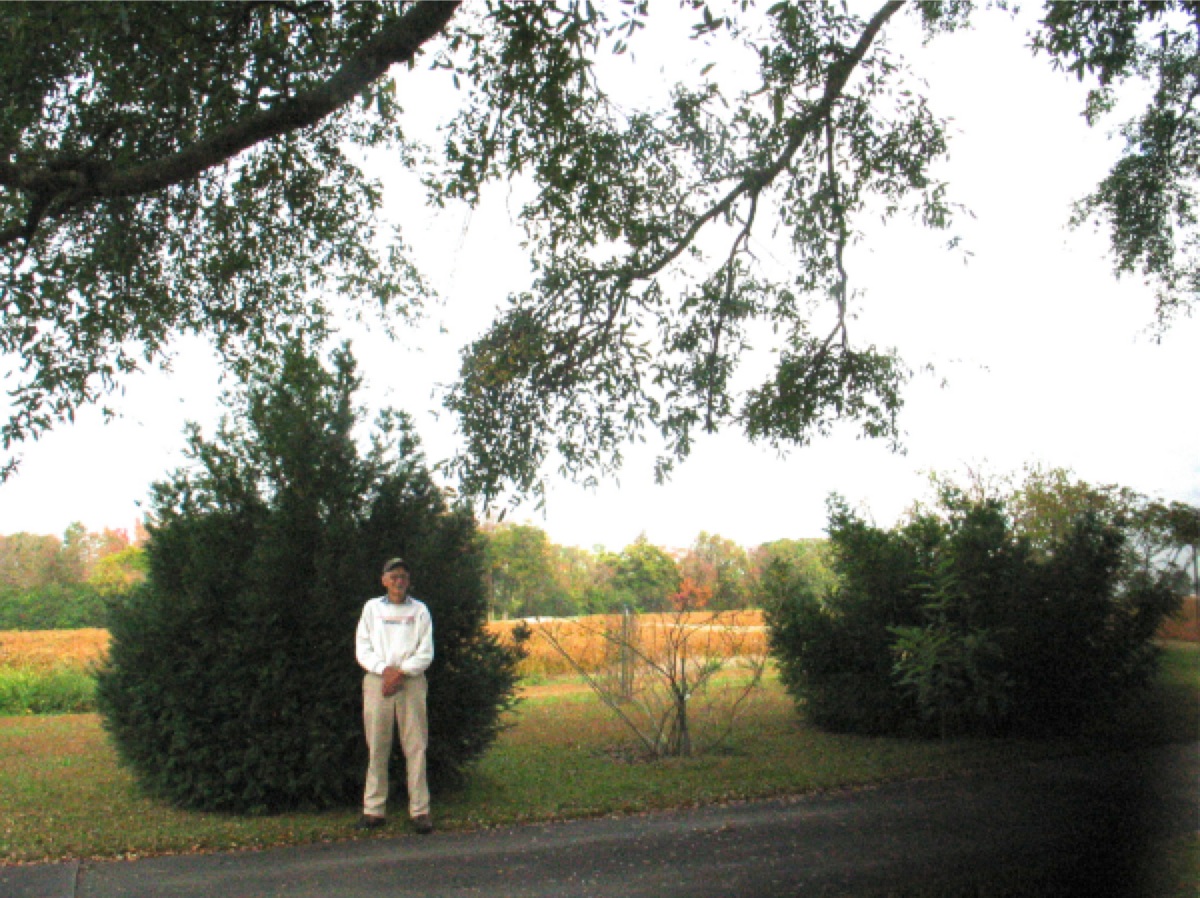
ABOVE LEFT (NY): Famed botanist H.W. Sargent wrote a supplement to Treatise on the Theory and Practice of Landscape Gardening, by A.J. Downing, 6th edition published in 1859. See also his description on page 49 of the February 1859 issue of American Agriculturalist, which includes "My best specimen is about 10 feet high, very dense, showing nothing but foliage like a dense arbor vitae and remarkable, particularly in the Winter, for the star like appearance of the extreme tip of its young shoots. I have reports of this tree from Elizabethtown N.J., Dobbs Ferry, Yorkville, Flushing, and Newport, in all of which places it succeeds well; considered hardy except in Newport where it is reported tender."
This Torreya taxifolia specimen is attributed to Sargent's own property at his home in Beacon, NY. Peter Del Tredici (pers comm. 2019) wrote, "It might be the first image of a cultivated specimen of the tree." Its caption reads: "Torreya taxifolia, at Wodenethe, Age, 6 years. Height, 8 feet. Circumference 20 ft." Note: Sargent himself clarified the fate of this specimen in the November 1875 issue of American Agriculturalist, page 428:
"I can supply the history: Mr. Downing for many years kept the plant in his greenhouse, and when this was broken up, he gave it to me. I then subjected it to a course of treatment detail on pages 475-76 of my edition of Downing's Landscape Gardening, until it became ten feet high and quite as wide. After several years of apparent hardiness, it suddenly turned brown in the course of one night, and perished in a few days in the month of April, after going through the winter, and many previous winters without flinching. I always supposed that just as the sap was starting, it suddenly received a coupe de vent, as the French would say, i.e., some peculiar draft of wind, which gave it its death."
ABOVE RIGHT (NC): East of the mountains of North Carolina is Mt. Olive, home of A.J. Bullard, well known botanical naturalist. Here he stands in front of 2 specimens he planted at his home (photo October 2013 by Connie Barlow). See photo-essay of Mt. Olive torreyas.
BELOW (OH): The three fully exposed Florida Torreya trees at the home of Fred Bess near Cleveland OH exemplify the dense form. Biting winter winds, of course, killed the north windward side leaves when the protected potted seedlings were first planted out. But new growth adapted. Periodic branchlet diebacks in extreme winter conditions naturally "prune" the trees into even denser forms.

|
|
Most interesting is that the seeds all seem to be at wind-protected inner locations on the south side of the tree (see photos immediately below in October 2018 section). Because the female reproductive structures are pollinated during one growth season and must survive a full winter before ripening autumn of the following year, it is possible that the reason for the inner location of seeds is that nascent seeds on the outer branches are generally killed during the winter.
Or, possibly, the tree simply installs its female structures at greater depth than it does in warmer climes. More observations will be helpful.
|
PHOTOS BELOW show Fred Bess and Connie Barlow search for seeds within the inner depths on the south side of the female tree. (Female tree is far right in the photo above.) All photos taken October 2018.
October 2018: Compilation of 14 years of Biltmore photos document torreya's basal sprout adaptation
February 2004 was Connie Barlow's first visit to the naturalized grove of Florida Torreya at Biltmore Gardens (Asheville NC). This was the year that she and Lee Barnes and Paul S. Martin formed Torreya Guardians — and began to take action and advocate for poleward planting of this trapped glacial relict. Accordingly, she was keen on photo-documenting the set of original, 75-year-old trees and also their many sapling offspring in the surrounds. In September of 2004, the gardens were hit by destructive winds of two hurricanes. In 2006, Connie returned and photographed the damages — and what happened to the mature torreys when they were newly exposed to sun, owing to the windthrow loss of their white pine overstory.
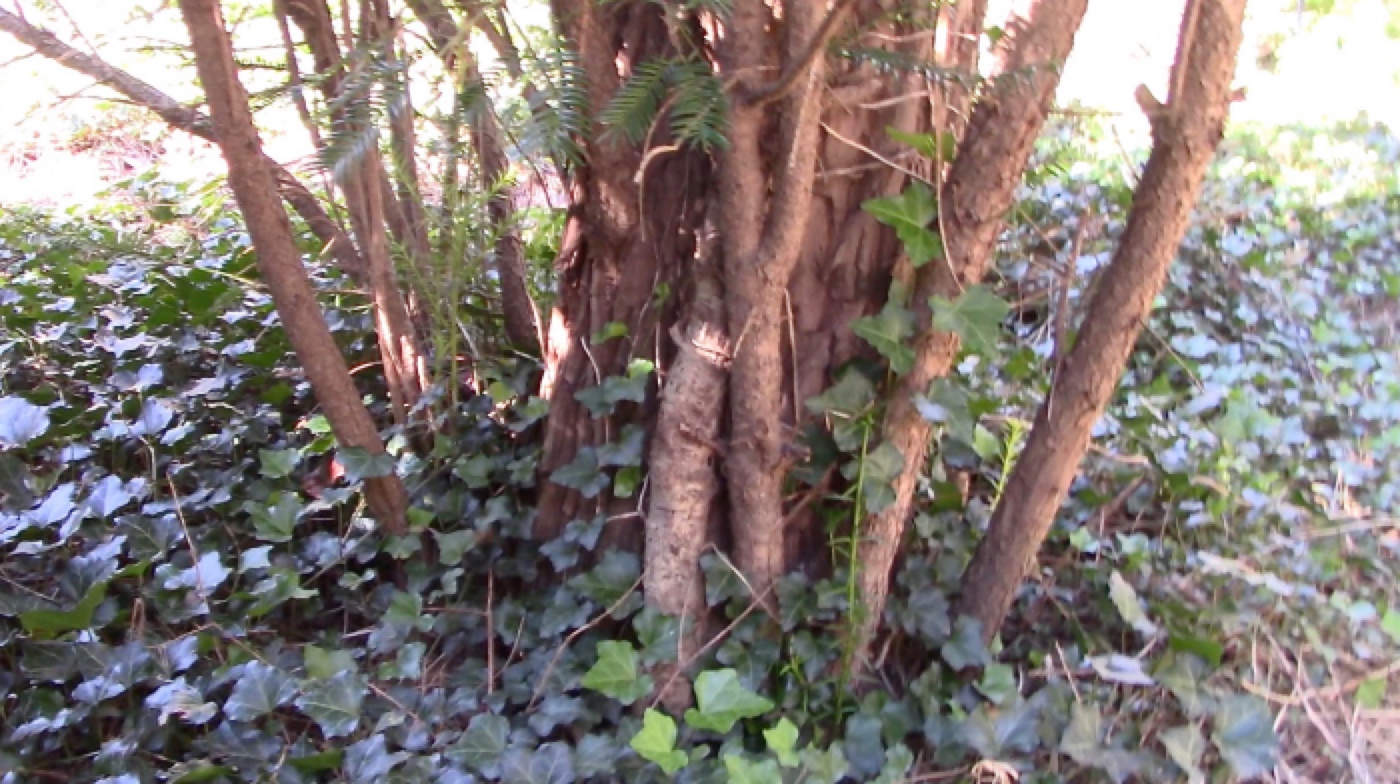 |
|
PHOTO LEFT: Her next visit was 2015, at which time she videoed the changes, including an abundance of basal sprouts emanating from the root crown of the top-cut specimens.
October 2018 marked her most recent visit. Again, she documented the changes.
There is a great deal to learn by viewing this sequence of 14 years of changes at this subsection of our Biltmore Torreya page: "2004-2018 Hurricane Damage and Basal Growth:" photos by Connie Barlow
|
• October 2018: Parma OHIO seed-grown Torreya female produces 19 seeds
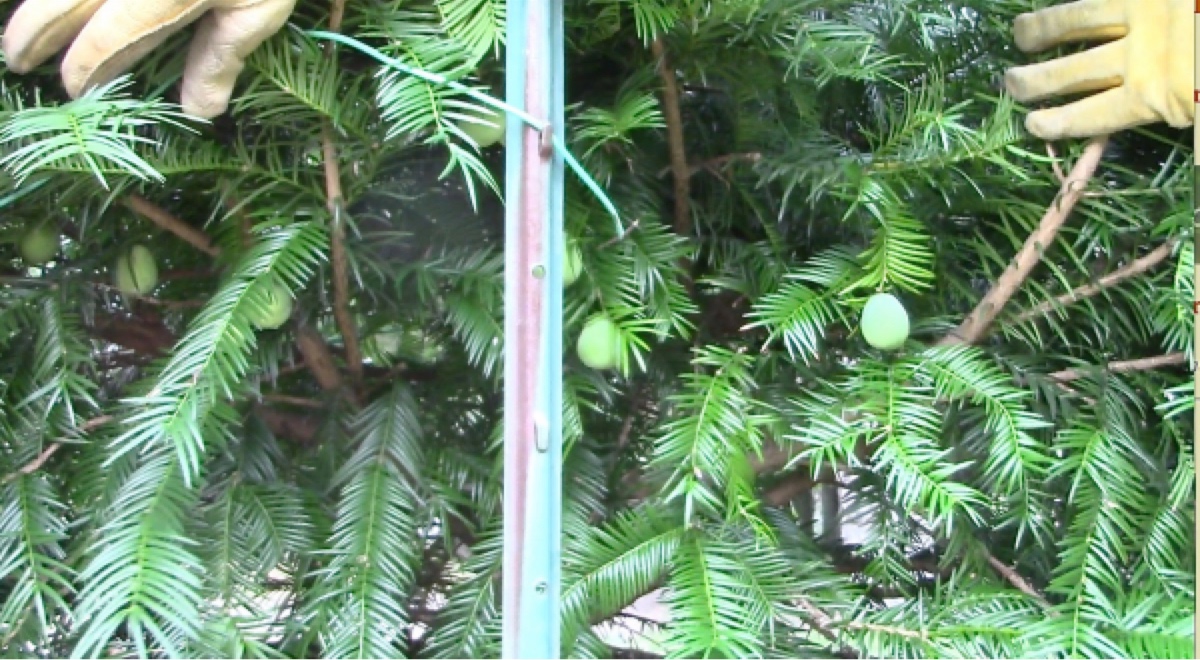
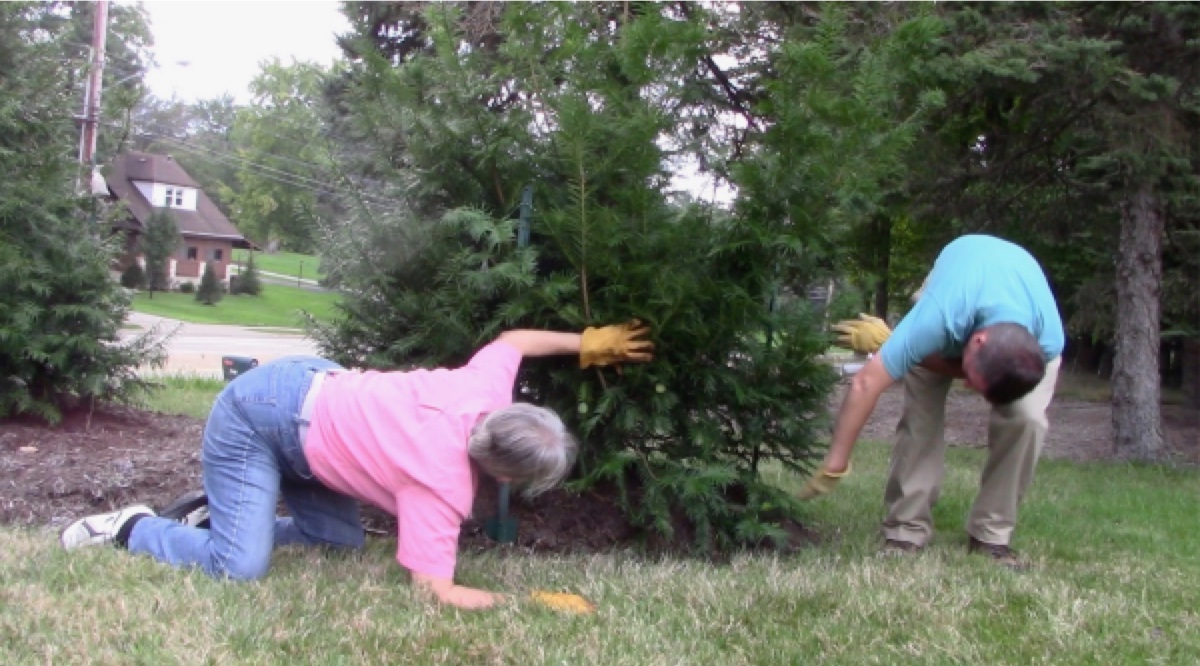
Connie Barlow and owner-grower Fred Bess search for seeds on October 2. All 19 are on the sunniest side of the tree (see the tall Blue Spruce at far right). All seeds are hidden/protected from winter winds by growing on interior branchlets of the kind of dense, Christmas-tree form that Torreya saplings assume when afforded a lot of sun. (Surroundings must be mowed to make this possible; otherwise, regrowth forest and shrubs shoot up much faster than torreya can grow.)
The seeds will become orange-purple when ripe in late October. Squirrels will likely be able to steal the seeds from the lowest branches, but the needles are so sharp (notice the gloved hands) and the tree so shrubby that the several that are 2 or 3 feet high may be safe from rodents.
Visit the Parma Ohio Torreya webpage, for the full image-rich, year-by-year report of Fred's set of four torreyas (2 females, 2 males), and WATCH VIDEO (below):
 |
|
KEY FINDINGS:
1. These trees have put forth leaves well acclimated to severe cold spells in Ohio.
2. Seeds are produced only on the branches that receive nearly full sun. (Connie notes from her 2005 site visit to wild California Torreya habitat that this seems to be a standard of the genus.)
VIDEO: 14 minutes, filmed 2 October 2018
|
February 2018: Learning Florida Torreya's capabilities by visiting its California cousin
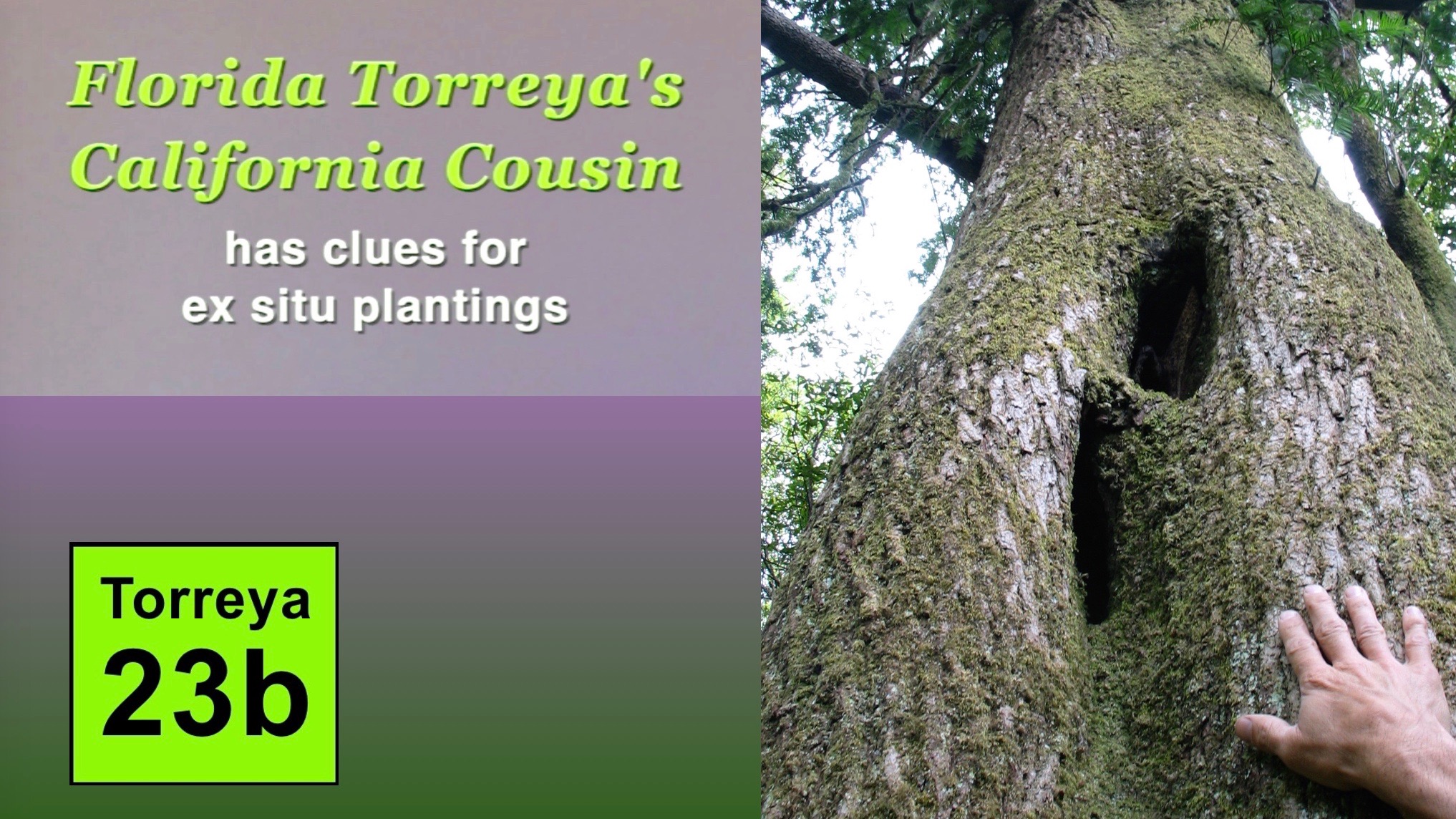 |
|
In 2005, Connie Barlow visited 4 forested regions in California where Torreya californica could be found growing in the wild. Her aim was to experience and photo-record observations of the trees and their surrounds such that volunteer planters of the Torreya species native to the eastern USA (along with professionals in charge of this endangered species' recovery) could discern habitat preferences of the genus and thus pinpoint similar environments in eastern states for planting seeds and seedlings.
Photo-essays of California Torreyas from her 2005 site visits have long been posted on this website, but in 2018 she edited them into a VIDEOBLOG in two parts: Part 1 (25 minutes) and Part 2 (27 minutes).
|
Key photos include those that demonstrate the ability of Torreya californica (a subcanopy tree) to grow on exceptionally steep and shady slopes — even in the company of forest giants such as Coast Redwoods and Douglas-fir.
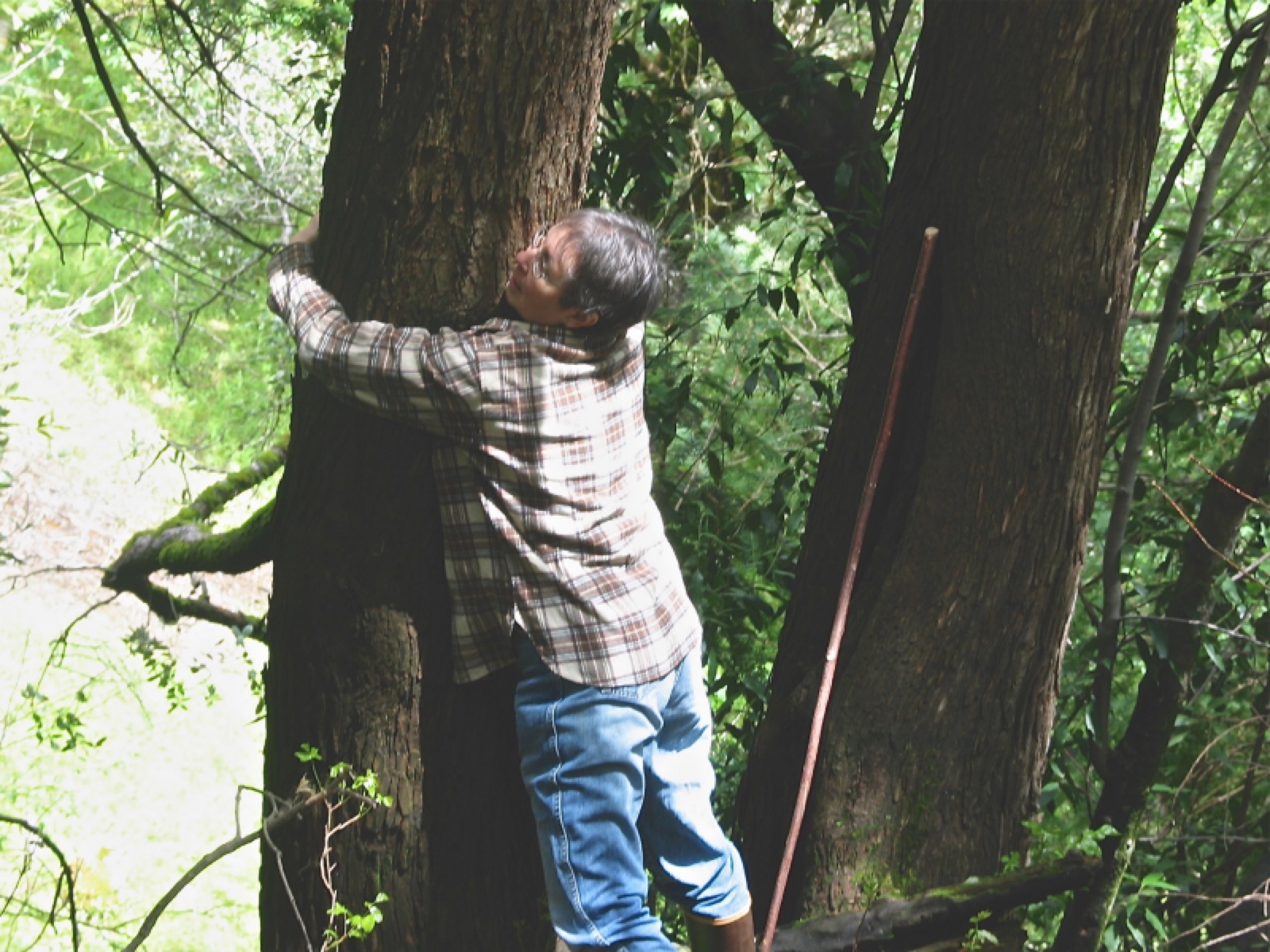

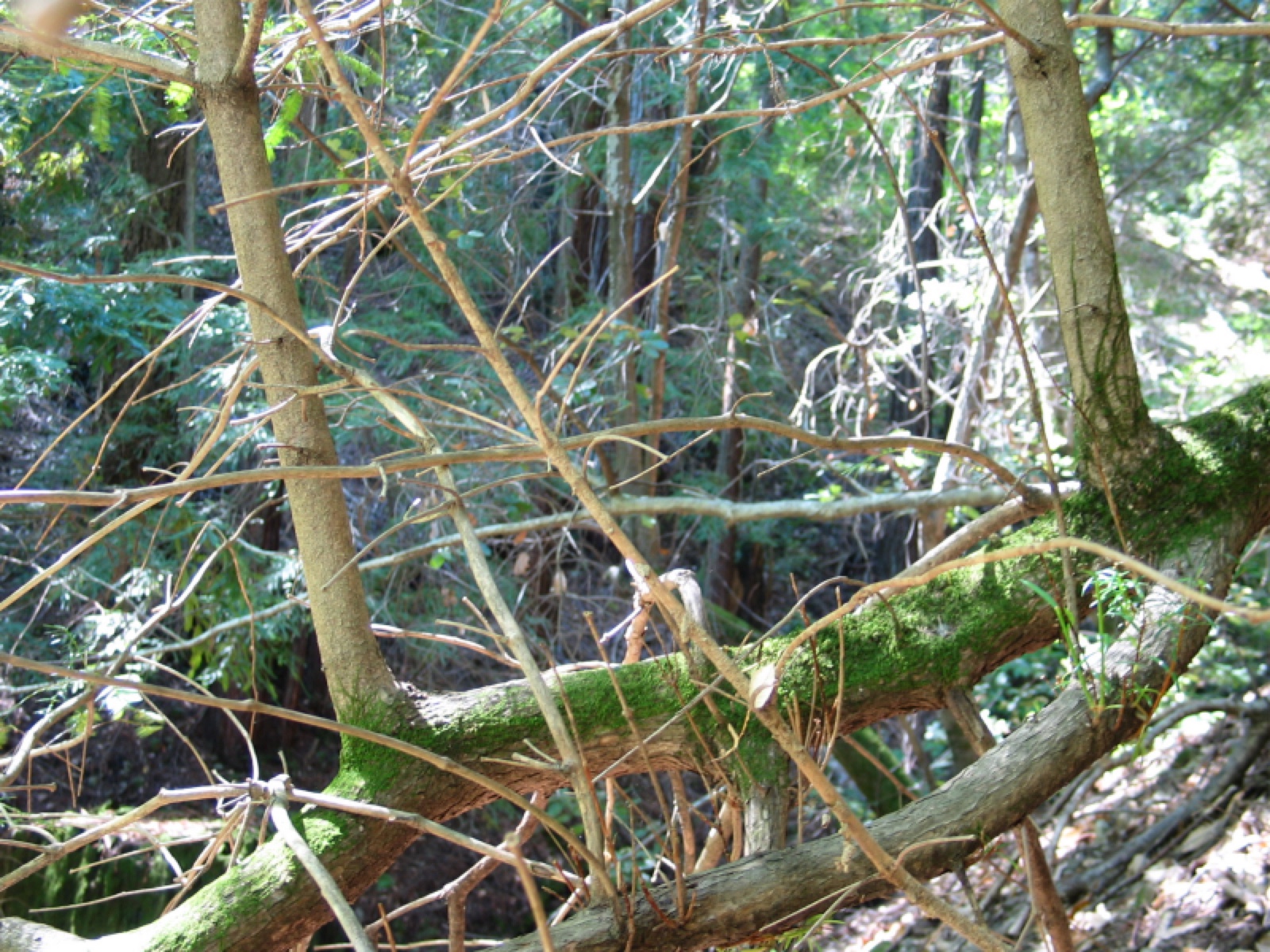
LEFT: Connie extends measuring tape around one trunk of a double-trunked tree in Kings Canyon Sequoia National Park.
MIDDLE: This genus keeps resprouting new basal stems, even when disease-free, in quest of sunlight. The moss-laden left-leaning stem is still alive and has sprouted a series of vertical branches along its now-horizontal stem (Coast Range near Calistoga).
RIGHT: Another example of a downslope-leaning healthy stem sporting vertical stems reaching for dappled sunlight. (Coast Range near Calistoga).